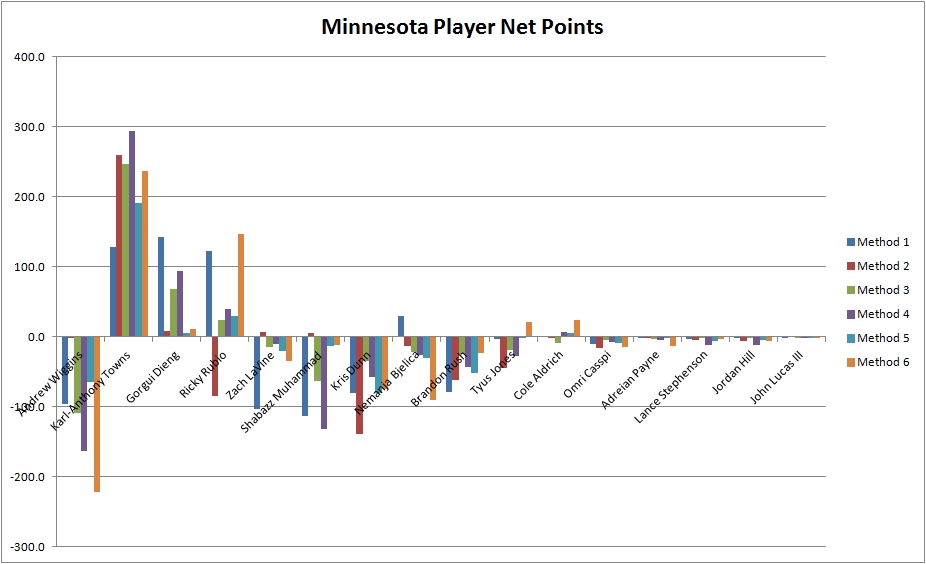
THE MINNESOTA TIMBERWOLVES WERE THE MOST INTERESTING TEAM analytically last year. And maybe for the last two years.
First of all, they had Ricky Rubio, whose value is about the least agreed upon thing in analytics. To be clear, there isn't a consensus on the best player value metrics in basketball. Basketball-Reference has at least 3 different metrics (VORP, BPM, Win Shares), ESPN has at least two (PER and RPM). VORP and Win Shares have Rubio pretty average, but BPM has him as a good player. PER ranks Rubio fairly average. RPM has ranked him in the top 40 of NBA players most years. A Harvard group wrote a piece for an ESPN spinoff on evaluating players using player tracking and where they were on the court and it suggested that Rubio was the worst player in the NBA. Benjamin Morris wrote a piece for another ESPN spinoff using analytical work to show that Rubio's skills were elite.
Rubio is now gone, shipped to Utah for nothing but a future lottery-protected first round pick. Rubio's obvious liabilities in shooting anywhere on the court are now replaced with the more obvious offensive assets of Jeff Teague. Whatever intangibles that RPM and Morris tried to make tangible in their systems - they remained intangible enough to the Wolves to let a starter go for a likely bench player.
Second, they had both Andrew Wiggins and Zach Lavine, athletic wings who could score but had issues doing other things. Lavine suffered a season-ending injury in early February, so we got to see what the team was like with just one of them. The team improved from winning about 34% of its games to 43% of its games. That improvement wasn't significant in a statistical way, but what was significant was that the offense got a lot better with him out.
Over this period of time when Lavine was out, ESPN's RPM metric steadily declined for Lavine. To emphasize, even though Lavine wasn't playing, his performance was looking worse. He wasn't actually costing the team points by sitting on the sideline, but the estimate was dropping like a rock as the Wolves played better without him. On February 15, he had supposedly added 1.9 wins to the team. By the end of the season, he had added 0.3 wins. RPM was doing an estimate of his value and that updated estimate kept going down, even though he wasn't doing anything.
Third, the Wolves had the biggest deviation in wins from the expected wins based on points scored and allowed. This team won 31 games and should have won 38 based on typical models. Usually this is associated with teams bad in close games, but the Wolves were 9-14 in those games, about what you would expect from a team that had their overall success.
Finally, this was supposed to be a good defensive team under new head coach Tom Thibodeau, who had been credited for great defenses in Chicago, Boston, and Houston. They were 26th, 24th in the halfcourt and dead last in transition. That wasn't supposed to happen, but...
In this offseason, the Timberwolves managed to get Jimmy Butler from the Bulls for Zach Lavine, Kris Dunn, and a draft pick that ended up as Lauri Markkanen. They also dumped Rubio for Jeff Teague. All of these moves make the team better defensively. Butler was, by most methods, one of the NBA's best players in 2017 and has been for several years, especially on the defensive side. Though Teague and Wiggins are below average defensively, they aren't as bad as what went away. I expect the defense on this team to be top 8 in 2017-18, maybe top 5.
No matter what method you use, the Timberwolves are one of those teams with the player having the most minutes for them (Wiggins) being below average. That is a formula for struggling. But Karl Anthony-Towns looks like a superstar or at least like a star, depending on what method you want to use.

What's fascinating about this plot is the huge variation in player valuation across the metrics. Rubio stands out, not surprisingly. One method said he was worth about 120 points more than average, another method said he cost them over 100 points compared to average. Three other methods had him marginally better than average. But their three wings - Wiggins, Lavine, and Muhammad - all looked better by the method that didn't like Rubio, considering them about average. The first method and the second method also don't generally agree on Towns vs Dieng. Though the first method likes Towns, it gives a lot of credit to Dieng, naming Dieng the "best" player on the team, followed closely by Towns and Rubio.
Among NBA teams, the Wolves had about the most players ranking high in uncertainty across the metrics. I don't have a perfect measure of "uncertainty" across those metrics (so there is uncertainty in the uncertainty), but you can see it.